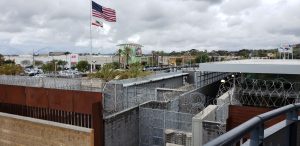by Lucy Hood
The United States has implemented travel restrictions on an unprecedented scale in recent weeks that immigration experts say are riddled with loopholes and devised in a way that puts vulnerable populations at risk.

This is especially true at the U.S.-Mexican border, they said, where tens of thousands of migrants living in shelters in northern Mexico now have a very slim, if any, chance of pursuing their asylum cases in U.S. immigration courts.
The Trump Administration recently closed the border to nonessential traffic, and in the process invoked a little-known health code to effectively bring asylum petitions to a standstill, said Alex Aleinikoff, director of the Zolbert Institute on Migration and Mobility and a former United Nations High Commissioner for Refugees.
“It clearly gets rid of any kind of process at the border for people and simply pushes them back,” said Aleinikoff, one of three panelists in a recent discussion on immigration controls and the coronavirus sponsored by the Migration Policy Institute.
“My guess is no matter what the situation of the virus over the next few months” he added, “this order will be kept in place for a long time to come.”
Closing the southwest border is one of many travel restrictions imposed by the Trump administration since Jan. 31. Others include travel bans preventing people in China and western Europe from coming into the United States.
The travel bans, Aleinikoff noted, had several exceptions – U.S. citizens, their spouses, green card holders, and parents and siblings of citizens. These exceptions, as well as flaws with passenger screenings and overcrowding at airports, created ample opportunity for the virus to get through.
“There is a clear public health justification for trying to slow the spread by keeping people out who might be carrying the virus,” Aleinikoff said.
But the idea of immunizing the United States from the rest of world hasn’t worked, he said.
With the onset of COVID-19, the United States and countries around the world have enacted more sweeping travel restrictions than ever before, said Natalia Banulescu-Bogdan, associate director of MPI’s International Program.
There is no question, she said, that migration management strategies need to be in place, but they are only part of the solution. When implemented well, they create time for implementing other measures, such as internal tracking systems, testing protocols and distancing norms, but they also come with potential pitfalls.
“The disproportionate focus on the border,” she noted, “created the impression that we could wall ourselves off from this disease, and we can’t.”
In addition, she said, many politicians have been quick to make the link between foreigners and disease, often giving the impression that the COVID-19 was an invasion, of sorts, and that the threat was external when, in fact, it had become very much internal.
“There is a possibility that without the distraction of linking foreigners and disease, we might have acted sooner to limit the spread within our own country,” Banulescu-Bogdan said.
She also said it’s paramount that special measures are taken to address the needs of vulnerable populations. One of the greatest resources in fighting the virus, she said is the willingness of people to disclose their symptoms, but they will not do that if they fear legal or financial repercussions.
“Our weaknesses in stopping the spread of the virus will map onto the existing fissures and weaknesses of our immigration systems… If we’ve learned anything it’s that the solutions to this crisis cannot be piecemeal. It’s about society working in unison toward a common goal,” she said.
MPI’s panel discussion served as a stark reminder of a national tendency to blame people from abroad for pandemic outbreaks in the United States, and the coronavirus is no exception. As The New York Times reported earlier this month, several Asian-American have been harassed in public, and many are now afraid to go to grocery stores, travel alone in public or let their children play outside.
“This other pandemic is not likely to recede anytime soon…” – Alan Kraut
Alan Kraut, a history professor at American University and an MPI resident fellow, described a long list of pandemics in the United States that went hand-in-hand with the stigmatization of certain groups of people. Irish Catholic immigrants, for example, took the blame for two successive cholera outbreaks, the Chinese for the bubonic plague, and Haitians for the AIDs epidemic.
“As frightening as the effects of the coronavirus are for our bodies,” Kraut said, “there is an additional reason for fright, I would suggest, and that is the effects of the pandemic on our respect and our treatment of those who are not like us.
“This increasing frequency of prejudice fueled by fear I have been calling the other pandemic,” he said, “and this other pandemic is not likely to recede anytime soon.”
Lucy Hood is a North Carolina-based immigration and education reporter and a contributor to ChicoSol.
